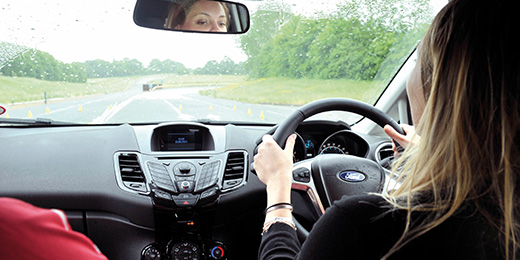Customers and Products > Improving Vehicle Safety >
Encouraging Safer Driving
To us, driver safety is not just about making safer vehicles. We’re also encouraging safer behavior behind the wheel through a range of programs around the world, including our flagship Driving Skills for Life (DSFL) initiative.
Ford Driving Skills for Life

Ford Driving Skills for Life (Ford DSFL) was established in 2003 by Ford Fund, in partnership with the Governors Highway Safety Association (GHSA) and a panel of experts, to teach newly licensed drivers the necessary skills for safer driving, and the importance of making good decisions behind the wheel. The core curriculum – vehicle handling, hazard recognition, driver distraction, and speed and space management – is delivered through hands-on courses, classroom material and the Ford DSFL website, which includes an interactive training center (“The Academy”).
As we expand the program, we adapt it to suit different regions. In North America and Europe, the Ford DSFL programs help teenagers – the primary age group of first-time drivers – drive more safely. For example, the Ford DSFL National Tour delivered free hands-on training sessions in 20 U.S. states during 2016. Meanwhile, in many Asian, Middle Eastern and African markets, where the number of new drivers is increasing rapidly as more people are able to afford vehicles, Ford DSFL is aimed at novice drivers of all ages.
See how we’re delivering Ford’s DSFL program around the globe
Progress in 2016
Our global reach spread further in 2016 to 150 markets around the world, with first-time programs in Finland, Poland, Korea, Kenya, Nigeria and Uganda; Hungary and Norway will be added in 2017.
Now in its 14th year, Ford DSFL had reached more than 1 million young people and newly licensed drivers in 35 countries at the close of 2016. This includes 200,000 people attending free, behind-the-wheel training and 800,000 people taking The Academy’s online training modules, and equates to an investment of nearly $60 million in promoting safety on the road.
Addressing Driver Distraction
Ford conducts a significant amount of research into driver distraction, both on our own and through partnerships with universities and organizations such as the Alliance of Automobile Manufacturers (Auto Alliance), to help make driving safer for everyone. Studies have demonstrated the importance of having drivers keep their hands on the wheel and their eyes on the road, informing the development of some driver assist technologies such as Forward Collision Warning, Automatic Emergency Braking, lane-keeping systems and SYNC®, which permits hands-free, voice actuation of several phone, navigation and audio features.
Driving Under the Influence...
To educate teens and new adult drivers about the dangers of driving while under the influence of alcohol or drugs, we have worked with the Meyer-Hentschel Institute in Germany to produce tailor-made “Drink Driving Suits” and “Drug Driving Suits.” Students attending Ford DSFL driving clinics during 2016 got to try both suits to understand how being impaired can slow movement, reduce reaction times, and affect vision and coordination.
See the “Drink Driving Suits” in action.
See the “Drug Driving Suits” in action.
...Even the Next Day
Drink driving is now one of society’s biggest taboos but hitting the road the next morning can be just as dangerous. Even when drivers are no longer over the legal alcohol limit, drivers are likely to be sleep deprived and have slower reaction times.
That’s where the “Hangover Suit,” again developed by the Meyer-Hentschel Institute, comes in. Weighing more than 17 kg, the suit – currently available on Ford DSFL courses in Europe – consists of a special vest, wrist and ankle weights, weighted cap and goggles, and headphones. Together, these simulate the classic hangover symptoms of fatigue, dizziness, sensitivity to sound, a throbbing head and difficulty concentrating.
Anatomy of a “Hangover Suit”
Ford’s “Hangover Suit” simulates all the classic hangover symptoms of a throbbing head, feeling tired and weak for the person wearing it.

